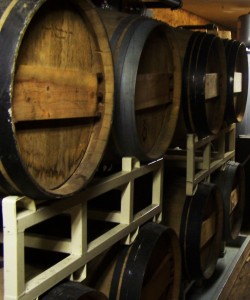April 18th, 2013 | News
By the end of 2012 there were, according to the Brewers Association, 2347 breweries operating in the United States. This includes everything from the local brewpub to the largest regional brewery. In other words, the US is currently experiencing more beer production than it ever has before. With all the ‘competition,’ breweries are constantly having to push the boundaries in order to keep up with increasing consumer savvy. This translates to new and innovative styles of beer but also reverting back to traditional methods previously unseen in the US. It is for these reasons Fegley’s Brew Works has been producing award winning lambics for over 10 years.
The very definition of lambic is a Belgian ale fermented with wild yeast (spontaneous fermentation) resulting in a purposeful souring of the beer. While wild yeast are partially responsible for sour ale production, open top fermentors exposed to the outdoors are another part. Most breweries shy away from lambics due to the intentional infection with “good” bacteria needed to sour the ales. The risk of cross contamination in the brewery is too great, and most are unwilling to take that risk.
 Brewers pride themselves on their creativity but also reproducibility. It can be said that it is an art to write a recipe for a beer but it is a science to reproduce it. Lambics are highly creative but incredibly difficult to duplicate. It is these characteristics of this style that make them resemble wine more so than beer. A vintner is at the mercy of the season to produce a quality wine. For these reasons certain years, or vintages, are more sought after than others and like wine are known to age well.
Brewers pride themselves on their creativity but also reproducibility. It can be said that it is an art to write a recipe for a beer but it is a science to reproduce it. Lambics are highly creative but incredibly difficult to duplicate. It is these characteristics of this style that make them resemble wine more so than beer. A vintner is at the mercy of the season to produce a quality wine. For these reasons certain years, or vintages, are more sought after than others and like wine are known to age well.
Over the years Fegley’s Brew Works has masterfully created a variety of lambics, ranging from framboise (raspberry), kriek (cherry), peche (peach), mirabelle (plum), cassis (black currant) and cranberry. Lambic brewing is a time consuming process lasting upwards of one year. Like any company that produces a commodity both time and space are valuable. It is impossible to tie up a fermentor with an aging lambic and still maintain a normal production schedule. That’s why in 2010 Fegley’s Brew Works bought over 30 wine barrels from a well known Napa Valley vineyard. The barrels allow the brewery to maintain a normal schedule but also the lambics aged within will take on certain qualities from the barrels. Wines like a dry Pinot Grigio or a Cabernet Sauvignon, possess oak or wood tannin flavors from the barrels they were aged in. The same is true for the first round of our new lambic series.
Since the decision was made to move forward with lambic production the scope of the project has changed form. “ No beer shall be served before its time”. Not all of the lambics in the wine barrels have aged in the same manner and at the same rate. As the brewery staff we decided instead of releasing a large volume of lambics annually we would rather have a limited release frequently throughout the year. This ensures the time needed for the slower maturing barrels while freeing up the ones that are ready to be served. This is determined by our brewers who must painstakingly sample all the barrels to single out the best ones. The chosen ones are then transferred to one of our Bright Tanks where the beer is chilled and carbonated.
Now that we have emptied a barrel we must refill it to keep the cycle moving. This is accomplished by using very “young” (partially fermented) Steelgaarden Wit. A Wit bier uses similar raw materials as a lambic. This makes a suitable and convenient replacement for the lambic we removed from the wine barrels. The “funk” or good bacteria left in the wine barrel is the catalyst to start the souring process. The brewers further inoculate the new beer with a culture grown in the “Mother”. Like sourdough bread the mother is the source of the unique bacteria culture used to age our lambics. Some sourdough bakeries in San Francisco have been feeding their mother culture for over 100 years. While our culture is not that old it will yield a truly unique beer everytime.